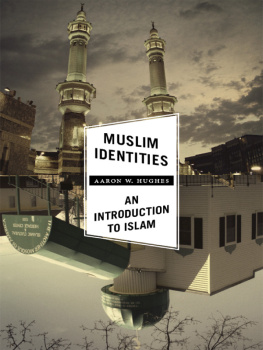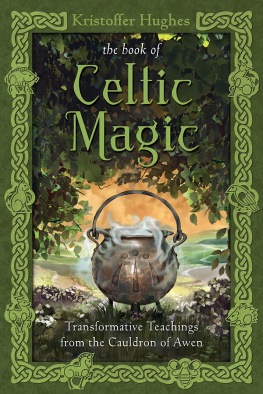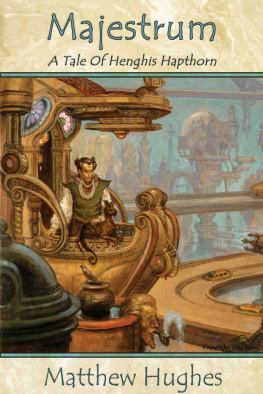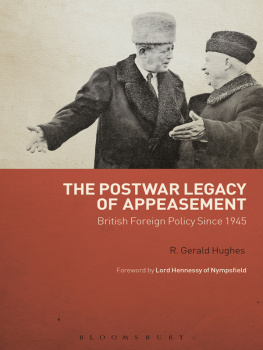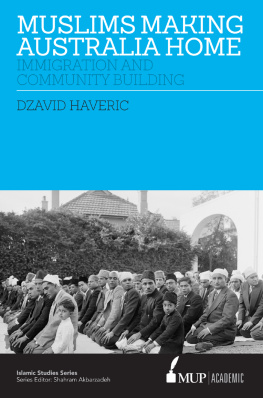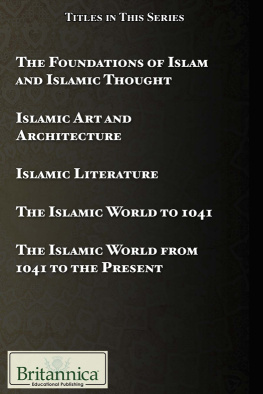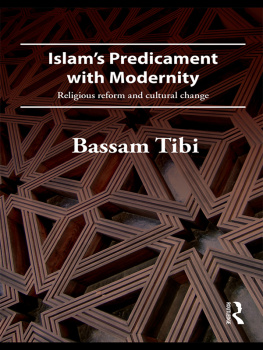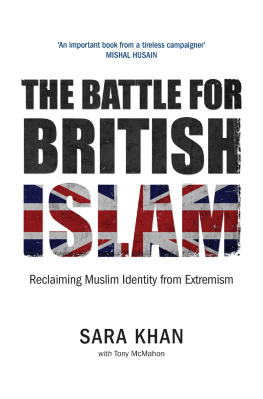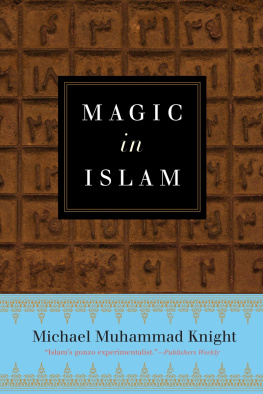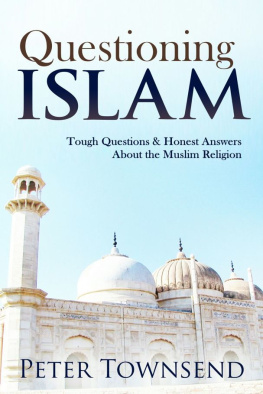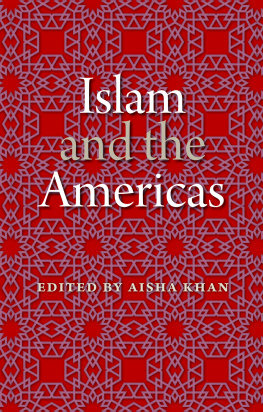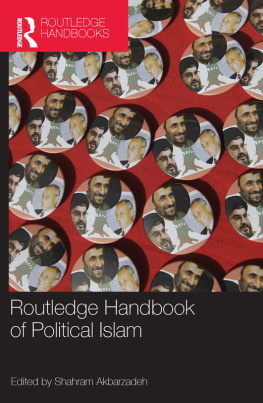Muslim Identities
AARON W. HUGHES
Muslim Identities
AN INTRODUCTION TO ISLAM
Columbia University Press New York
Columbia University Press
Publishers Since 1893
New York Chichester, West Sussex
cup.columbia.edu
Copyright 2013 Columbia University Press
All rights reserved
E-ISBN 978-0-231-53192-4
Library of Congress Cataloging-in-Publication Data
Hughes, Aaron W., 1968
Muslim identities : an introduction to Islam / Aaron W. Hughes.
p. cm.
Includes bibliographical references and index.
ISBN 978-0-231-16146-6 (cloth : alk. paper) ISBN 978-0-231-16147-3 (pbk. : alk. paper)
ISBN 978-0-231-53192-4 (e-book)
1. Islam I. Title.
BP161.3.H84 2013
297dc23
2012036923
A Columbia University Press E-book.
CUP would be pleased to hear about your reading experience with this e-book at .
COVER DESIGN: Martin Hinze
COVER IMAGES: (top) Grand Mosque, Mecca, Saudi Arabia (photograph by Basil D. Soufi; courtesy of Wikimedia Commons); (bottom) Mother Mosque of America, Cedar Rapids, Iowa (photograph by Rifeldeas; courtesy of Wikimedia Commons)
References to Internet Web sites (URLs) were accurate at the time of writing. Neither the author nor Columbia University Press is responsible for URLs that may have expired or changed since the manuscript was prepared.
In memoriam
May Alley
(19082009)
CONTENTS
R ELIGIONS, INCLUDING Islam, mean a great deal to individuals across the globe: they are perceived to give solace to the weak and the oppressed, comfort to the sick and the dying, and memories to the dead. Any book that seeks to introduce readers to a religion must accordingly respect this feature of the religion. In addition, the line between insider and outsider to the religion, which I discuss more fully in the introduction, is often a very fine one that must be crossed with care.
It is precisely because of these issues that many are either unused to or uncomfortable with speaking about religions using terms and categories normally relegated to explicating more mundane phenomena. Although the latter approach is increasingly becoming normative in introducing aspects of religions such as Judaism and Christianity (e.g., Second Temple Judaism, the historical Jesus), it is only just beginning to enter the introduction to Islam classroom. This book attempts to be a part of this process, but in a way that remains sensitive to possible tensions that emerge from such a discourse. Chapters weave both outsider and insider accounts of Islam together so as to appreciate Islam more fully as a historical force.
This books goal is accordingly to reach some sort of middle ground between what Muslims believe and what certain trends in the academic study of religion tell us to attune ourselves to. The equilibrium required is a very delicate one.
Yet an introductory work that is perceived to be solely about including the traditionally occluded, although interesting, would not necessarily inform us about Islams staying power. As a result, I have included chapters that deal with beliefs and practices. However, I attempt to show how these beliefs and practices are both historically conditioned and emergelike all belief and practicesfrom various contestations and struggles that can be documented historically.
A Word on Sources
I try not to bombard readers with notes. When I do use them, it is to show some of the debates in the secondary literature or to show the source of a particular interpretation. At the end of each chapter, I include a section entitled Suggestions for Further Reading. The books listed are the sources from which I derived most of my data and are the place to which the interested reader should go to inquire further into a particular topic. Unless otherwise noted, quotations from the Quran come from Alan Jones, trans., The Quran (Exeter, Eng.: Gibb Memorial Trust, 2007).
A Note on Transliteration
For better or worse, many scholarly books on religion tend to use diacritical marks to indicate how a word is pronounced in a particular language, especially if that language uses a different alphabet. This is how Islamicists or religionists tend to signal their scholarly bona fides to one another and to nonexperts. I debated whether to use such diacritics in this book and ultimately decided not to, for two reasons. First, I do not want to bombard the beginning reader with pages of unfamiliar diacritical marks on words that may already appear quite unfamiliar. Second, at this stage in technology, diacritics pose all sorts of problems for e-book formatting. For the sake of convenience and for the reader interested in diacritics, however, I have included them in the presentation of terms that appear in the glossary. Words that appear in bold in the text can be easily referenced in this glossary. I occasionally use the ayn () and hamza () in words. I do this not out of philological precision, but because this is the way that such names and words (e.g., Shii, tawil) usually appear.
A Note on Dates
Dating can also pose a host of problems because Muslims use a different system that marks the passing of time, one that revolves around the importance of the hijra, or exodus, of Muhammad and his earliest followers to Medina (for details, see ). For the sake of convenience, I have used the Gregorian calendar but reduced it to the Common Era (B.C.E./ C.E.), which is familiar to Western audiences.
I T IS a difficult task to acknowledge the many intellectual debts I owe for a work in which I have involved myself on and off for more than two decades, but I can try. Earle H. Waugh first exposed me to the academic study of Islam when I was a young undergraduate at the University of Alberta. Little did I imagine that his Introduction to Islam in the fall and Introduction to the Quran in the winter of 1990 would lead me to devote my intellectual life to Islamicate studies. I now find myself in the uncanny position of producing the present volume as a way to introduce a new generation of young minds to this living and dynamic tradition. To my other gifted teachers at the University of AlbertaEhud Ben Zvi, Francis Landy, and the late Manabu Waida, I am also grateful. They set the stage for what has continued to be a lifetime of learning and intellectual inquisitiveness.
I also thank my other teachers, all of whom taught me much about Islam over the years: Scott C. Alexander, John T. Walbridge, Salman al-Ani, and Suzanne Stetkevych. Although I doubt they would agree with everything that appears in these pages, I do hope they realize what an indelible intellectual mark they have left on me.
In the other direction, I thank the students I have taught over the years. I have continually tested many of the ideas here on them, and many risen to the challenge. Teaching undergraduate students is truly one of the joys of this great profession.
I also have a large obligation to thank many of my professional colleagues who have either given me encouragement or commented on various parts of this book. I am indebted to Linda S. Adams, Herb Berg, Daniel J. Borsay, Arthur Franklin, Khaleel Mohammed, Russell T. McCutcheon, Martin Nguyen, David Powers, Paul Powers, Steven E. Sidebotham, Erin Stiles, David Valeta, Mark Wagner, and Peter Matthews Wright. I also thank Wendy Lochner, my editor at Columbia University Press, for supporting and believing in this project, and Annie Barva for the care with which she copyedited the entire manuscript.

